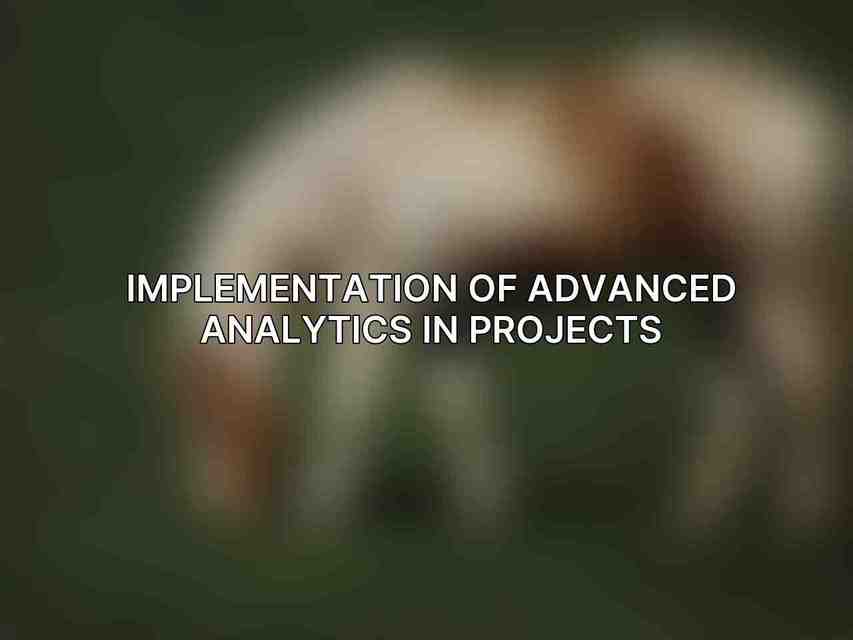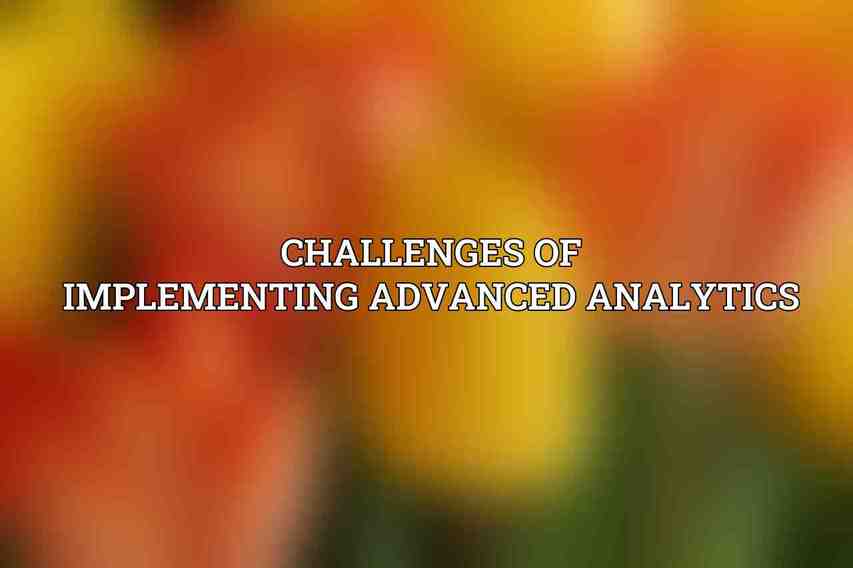Advanced analytics techniques refer to the use of sophisticated methods and tools to analyze data and derive insights that can drive better decision-making and performance. In the realm of project management, advanced analytics plays a crucial role in enhancing project outcomes, efficiency, and risk management. By harnessing the power of data, project managers can make informed decisions, predict future trends, and optimize project processes.
The importance of advanced analytics in project management cannot be overstated. In this dynamic business environment, projects have become more complex, with a myriad of variables influencing their success. Advanced analytics provides project managers with the tools to sift through vast amounts of data, identify patterns, and make accurate forecasts. These insights enable proactive decision-making, helping teams stay ahead of potential issues and adapt to changing circumstances swiftly.
Benefits of Utilizing Advanced Analytics in Projects
- Improved Decision-Making: By leveraging advanced analytics, project managers can make data-driven decisions based on insights rather than intuition.
- Enhanced Risk Management: Advanced analytics tools can identify potential risks early on, allowing for proactive risk mitigation strategies.
- Resource Optimization: Through data analysis, project managers can allocate resources more efficiently, reducing wastage and improving productivity.
- Cost Savings: Advanced analytics can help in identifying cost-saving opportunities and optimizing project budgets.
- Predictive Capabilities: By utilizing predictive analytics, project managers can forecast project outcomes and take preventive actions to ensure success.
Types of Advanced Analytics Techniques
Predictive Analytics
Predictive analytics involves using statistical algorithms and machine learning techniques to analyze historical data and forecast future outcomes. It goes beyond descriptive analytics by providing insights into what is likely to happen in the future.
- Techniques:
- Machine Learning: Utilizes algorithms to learn from data and make predictions or decisions without being explicitly programmed.
- Data Mining: Involves the process of discovering patterns and relationships in large datasets to extract valuable information.
- Statistical Modeling: Uses statistical techniques to analyze relationships between variables and make predictions based on data patterns.
Prescriptive Analytics
Prescriptive analytics focuses on providing recommendations on the best course of action to achieve a specific goal. It combines insights from predictive analytics with optimization and simulation techniques to offer actionable solutions.
- Techniques:
- Optimization: Seeks to find the best solution to a problem by maximizing or minimizing objective functions while satisfying constraints.
- Simulation: Involves creating models of real-world scenarios to analyze the impact of different decisions and strategies.
- Decision Analysis: Utilizes decision trees and algorithms to evaluate different options and choose the optimal path.
Big Data Analytics
Big data analytics involves processing and analyzing large and diverse datasets to uncover patterns, trends, and insights that would be challenging to discover using traditional methods.
- Techniques:
- Hadoop: An open-source framework for distributed storage and processing of big data across clusters of computers.
- Spark: A fast and general-purpose cluster computing system for big data processing.
- Hive: A data warehouse infrastructure built on top of Hadoop for querying and managing large datasets.
Data Visualization
Data visualization is the graphical representation of information and data. It uses visual elements like charts, graphs, and maps to communicate insights and patterns in data.
- Techniques:
- Tableau: A powerful data visualization tool that allows users to create interactive and shareable dashboards.
- Power BI: Microsoft’s business analytics service for creating interactive reports and dashboards.
- Google Data Studio: A free tool for creating informative and interactive dashboards that are easy to share and collaborate on.
Applications of Advanced Analytics in Project Management
The applications of advanced analytics in project management are diverse and impactful, spanning various areas of project execution and monitoring.
A. Risk Management:
– Advanced analytics can help in identifying potential risks early on, enabling project managers to implement risk mitigation strategies and avoid costly delays.
B. Resource Management:
– By analyzing resource allocation data, project managers can optimize resource utilization, identify bottlenecks, and ensure efficient resource deployment throughout the project lifecycle.
C. Scope Management:
– Advanced analytics tools can assist in defining project scope, tracking scope changes, and ensuring project deliverables align with stakeholder expectations.
D. Schedule Management:
– Predictive analytics can help in creating accurate project schedules by forecasting task durations, dependencies, and critical path analysis.
E. Cost Management:
– Utilizing advanced analytics, project managers can monitor project expenses, identify cost-saving opportunities, and ensure projects stay within budget constraints.
F. Quality Management:
– Data analysis techniques can be used to monitor project quality metrics, identify defects early on, and implement quality improvement initiatives.
G. Stakeholder Management:
– Advanced analytics can aid in understanding stakeholder preferences, expectations, and concerns, facilitating effective communication and stakeholder engagement.
Implementation of Advanced Analytics in Projects

Implementing advanced analytics in projects involves a systematic process of data collection, preparation, modeling, and deployment to derive actionable insights and drive project success.
A. Data Collection and Integration:
– Collecting relevant project data from multiple sources and integrating it into a unified dataset for analysis.
B. Data Preparation and Cleaning:
– Preprocessing raw data to ensure accuracy, consistency, and completeness before conducting analysis.
C. Model Development and Validation:
– Developing advanced analytics models, testing their performance, and validating their accuracy using historical data.
D. Deployment and Monitoring:
– Implementing analytics solutions into project management processes, monitoring their effectiveness, and refining models based on real-time feedback.
Challenges of Implementing Advanced Analytics

Despite the numerous benefits advanced analytics offers in project management, several challenges can impede its successful implementation.
A. Data Availability and Quality: Read more about this on A Comprehensive Guide to Analytics in Project Management
– Inadequate data quality or availability can hinder effective analysis and lead to unreliable insights, affecting decision-making processes.
B. Technical Expertise:
– Utilizing advanced analytics tools requires specialized technical skills and knowledge, which may be lacking in project management teams.
C. Cost and Resources:
– Implementing advanced analytics solutions can be resource-intensive, requiring investments in technology, training, and infrastructure.
Case Studies of Advanced Analytics in Project Management
A. Example 1: Using Machine Learning to Predict Project Risk
– By applying machine learning algorithms to historical project data, a construction company was able to predict potential risks and proactively implement mitigation strategies, reducing project delays and cost overruns.
B. Example 2: Utilizing Data Visualization for Resource Optimization
– A software development team used data visualization tools to analyze resource utilization patterns, leading to more efficient resource allocation, improved team productivity, and timely project deliveries.
leveraging advanced analytics techniques in project management offers a transformative approach to decision-making, risk management, resource optimization, and overall project success. By embracing data-driven insights and predictive capabilities, project managers can navigate complex project worlds with confidence, efficiency, and agility.
Summary of Key Points
- Advanced analytics techniques empower project managers to make data-driven decisions, predict future outcomes, and optimize project processes.
- Predictive analytics, prescriptive analytics, big data analytics, and data visualization are key components of advanced analytics in project management.
- The applications of advanced analytics in project management span risk management, resource optimization, scope management, and stakeholder engagement.
- Implementing advanced analytics in projects involves data collection, preparation, model development, and continuous monitoring.
- Challenges of implementing advanced analytics include data quality issues, technical expertise requirements, and resource constraints.
Future Trends in Advanced Analytics for Project Management
The future of advanced analytics in project management is promising, with emerging trends such as artificial intelligence, natural language processing, and augmented analytics poised to revolutionize how projects are planned, executed, and monitored. As technology continues to evolve, project managers who embrace advanced analytics will have a competitive advantage in delivering successful projects in a rapidly changing business world.
Frequently Asked Questions
What are advanced analytics techniques in project management?
Advanced analytics techniques in project management involve using sophisticated algorithms and tools to analyze project data, identify trends, predict outcomes, and make data-driven decisions.
How can advanced analytics benefit project management?
Advanced analytics can benefit project management by providing insights into project performance, resource allocation, risk management, and overall project success. It can help project managers make informed decisions and optimize project outcomes.
What are some popular advanced analytics techniques used in project management?
Popular advanced analytics techniques used in project management include machine learning, predictive modeling, data mining, text analytics, and visualization tools. These techniques can help project managers extract valuable insights from project data.
How can project managers leverage advanced analytics techniques effectively?
Project managers can leverage advanced analytics techniques effectively by collecting high-quality data, defining clear project objectives, selecting the right analytics tools, and collaborating with data scientists or analysts. It’s important to use analytics to inform decision-making and drive project success.
What are some challenges associated with leveraging advanced analytics techniques in project management?
Some challenges associated with leveraging advanced analytics techniques in project management include data quality issues, data privacy concerns, lack of expertise in analytics, and resistance to change. It’s important for project managers to address these challenges proactively and build a data-driven culture within their project teams.

